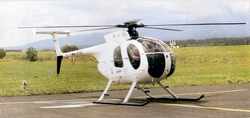Wed, Aug 21, 2013
Helicopter Long Line Was Hoisting Two Workers When It Severed
The NTSB has released a preliminary report from an accident involving a Hughes 369D helicopter that fatally injured two utility workers employed by Wind Energy Transmission of Texas.

According to the report, on August 5, 2013, at 0915 central daylight time, a Hughes model 369D helicopter, N8688F, was not damaged when its external cargo long-line was severed after colliding with a shield wire suspended between power transmission towers near Ackerly, Texas. The two linemen who were being hoisted on the long-line were fatally injured after falling about 200 feet to the ground after the collision. The helicopter was registered to and operated by Haverfield Aviation Inc., under the provisions of 14 Code of Federal Regulations Part 133 as an external load flight, without a flight plan. Day visual meteorological conditions prevailed for the local flight, which was operating from a landing zone situated near the accident site.
According to the operator, the helicopter was equipped with a 100-foot long external cargo long-line that was being used to hoist linemen onto power transmission towers. Shortly after departure, as the helicopter was climbing toward the transmission tower, the long-line collided with a shield wire suspended between transmission towers. The operator reported that the long-line severed about 5 feet above the linemen. The pilot returned to the landing zone and made an uneventful landing. The pilot did not report any malfunction or failures with the helicopter that would have prevented normal operation.
The nearest aviation weather reporting station was located at Big Spring McMahon-Wrinkle Airport (KBPG), Big Spring, Texas, about 20 miles southeast of the accident site. At 0915, the KBPG automated surface observing system reported: wind from 160 degrees at 11 knots, visibility 10 miles, sky clear, temperature 28 degrees Celsius, dew point 16 degrees Celsius, and an altimeter setting of 30.10 inches of mercury.
(Similar helicopter pictured in file photo. Not accident aircraft)
More News
From 2023 (YouTube Version): Legacy of a Titan Robert (Bob) Anderson Hoover was a fighter pilot, test pilot, flight instructor, and air show superstar. More so, Bob Hoover was an i>[...]
Get The Latest in Aviation News NOW on Instagram Are you on Instagram yet? It's been around for a few years, quietly picking up traction mostly thanks to everybody's new obsession >[...]
Aero Linx: B-52H Stratofortress The B-52H Stratofortress is a long-range, heavy bomber that can perform a variety of missions. The bomber is capable of flying at high subsonic spee>[...]
Altimeter Setting The barometric pressure reading used to adjust a pressure altimeter for variations in existing atmospheric pressure or to the standard altimeter setting (29.92).>[...]
"Knowing that we play an active part in bettering people's lives is extremely rewarding. My team and I are very thankful for the opportunity to be here and to help in any way we ca>[...]
 Classic Aero-TV: Remembering Bob Hoover
Classic Aero-TV: Remembering Bob Hoover ANN FAQ: Follow Us On Instagram!
ANN FAQ: Follow Us On Instagram! ANN's Daily Aero-Linx (05.15.24)
ANN's Daily Aero-Linx (05.15.24) ANN's Daily Aero-Term (05.15.24):Altimeter Setting
ANN's Daily Aero-Term (05.15.24):Altimeter Setting Aero-News: Quote of the Day (05.16.24)
Aero-News: Quote of the Day (05.16.24)



